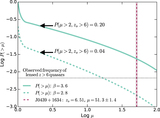Most Lensed Quasars at z > 6 are Missed by Current Surveys
Abstract
The discovery of the first strongly lensed (μ ≈ 50) quasar at z > 6 (J0439+1634) represents a breakthrough in our understanding of the early universe. We derive the theoretical consequences of the new discovery. We predict that the observed population of z > 6 quasars should contain many sources with magnifications μ ≲ 10 and with image separations below the resolution threshold. Additionally, current selection criteria could have missed a substantial population of lensed z > 6 quasars, due to the contamination of the drop-out photometric bands by lens galaxies. We argue that this predicted population of lensed z > 6 quasars would be misclassified and mixed up with low-z galaxies. We quantify the fraction of undetected quasars as a function of the slope of the bright end of the quasar luminosity function, β. For β ≲ 3.6, we predict that the undetected lensed quasars could reach half of the population, whereas for β ≳ 4.5 the vast majority of the z > 6 quasar population is lensed and still undetected. This would significantly affect the z > 6 quasar luminosity function and inferred black hole mass distributions, with profound implications for the ultraviolet, X-ray, and infrared cosmic backgrounds and the growth of early quasars.
- Publication:
-
The Astrophysical Journal
- Pub Date:
- January 2019
- DOI:
- 10.3847/2041-8213/aaf86a
- arXiv:
- arXiv:1810.12302
- Bibcode:
- 2019ApJ...870L..12P
- Keywords:
-
- dark ages;
- reionization;
- first stars;
- early universe;
- galaxies: active;
- galaxies: luminosity function;
- mass function;
- gravitational lensing: strong;
- quasars: supermassive black holes;
- Astrophysics - Astrophysics of Galaxies;
- Astrophysics - Cosmology and Nongalactic Astrophysics;
- Astrophysics - High Energy Astrophysical Phenomena
- E-Print:
- Theoretical follow-up of the discovery of J0439+1634, the first lensed z>
